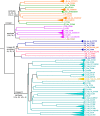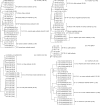Core Genome Multilocus Sequence Typing for Identification of Globally Distributed Clonal Groups and Differentiation of Outbreak Strains of Listeria monocytogenes
- PMID: 27520821
- PMCID: PMC5068157
- DOI: 10.1128/AEM.01532-16
Core Genome Multilocus Sequence Typing for Identification of Globally Distributed Clonal Groups and Differentiation of Outbreak Strains of Listeria monocytogenes
Abstract
Many listeriosis outbreaks are caused by a few globally distributed clonal groups, designated clonal complexes or epidemic clones, of Listeria monocytogenes, several of which have been defined by classic multilocus sequence typing (MLST) schemes targeting 6 to 8 housekeeping or virulence genes. We have developed and evaluated core genome MLST (cgMLST) schemes and applied them to isolates from multiple clonal groups, including those associated with 39 listeriosis outbreaks. The cgMLST clusters were congruent with MLST-defined clonal groups, which had various degrees of diversity at the whole-genome level. Notably, cgMLST could distinguish among outbreak strains and epidemiologically unrelated strains of the same clonal group, which could not be achieved using classic MLST schemes. The precise selection of cgMLST gene targets may not be critical for the general identification of clonal groups and outbreak strains. cgMLST analyses further identified outbreak strains, including those associated with recent outbreaks linked to contaminated French-style cheese, Hispanic-style cheese, stone fruit, caramel apple, ice cream, and packaged leafy green salad, as belonging to major clonal groups. We further developed lineage-specific cgMLST schemes, which can include accessory genes when core genomes do not possess sufficient diversity, and this provided additional resolution over species-specific cgMLST. Analyses of isolates from different common-source listeriosis outbreaks revealed various degrees of diversity, indicating that the numbers of allelic differences should always be combined with cgMLST clustering and epidemiological evidence to define a listeriosis outbreak.
Importance: Classic multilocus sequence typing (MLST) schemes targeting internal fragments of 6 to 8 genes that define clonal complexes or epidemic clones have been widely employed to study L. monocytogenes biodiversity and its relation to pathogenicity potential and epidemiology. We demonstrated that core genome MLST schemes can be used for the simultaneous identification of clonal groups and the differentiation of individual outbreak strains and epidemiologically unrelated strains of the same clonal group. We further developed lineage-specific cgMLST schemes that targeted more genomic regions than the species-specific cgMLST schemes. Our data revealed the genome-level diversity of clonal groups defined by classic MLST schemes. Our identification of U.S. and international outbreaks caused by major clonal groups can contribute to further understanding of the global epidemiology of L. monocytogenes.
Copyright © 2016 Chen et al.
Figures



Similar articles
-
Whole genome sequencing analyses of Listeria monocytogenes that persisted in a milkshake machine for a year and caused illnesses in Washington State.BMC Microbiol. 2017 Jun 15;17(1):134. doi: 10.1186/s12866-017-1043-1. BMC Microbiol. 2017. PMID: 28619007 Free PMC article.
-
Retrospective investigation of listeriosis outbreaks in small ruminants using different analytical approaches for whole genome sequencing-based typing of Listeria monocytogenes.Infect Genet Evol. 2020 Jan;77:104047. doi: 10.1016/j.meegid.2019.104047. Epub 2019 Oct 17. Infect Genet Evol. 2020. PMID: 31629888
-
Defining and Evaluating a Core Genome Multilocus Sequence Typing Scheme for Whole-Genome Sequence-Based Typing of Listeria monocytogenes.J Clin Microbiol. 2015 Sep;53(9):2869-76. doi: 10.1128/JCM.01193-15. Epub 2015 Jul 1. J Clin Microbiol. 2015. PMID: 26135865 Free PMC article.
-
Serotype to genotype: The changing landscape of listeriosis outbreak investigations.Food Microbiol. 2018 Oct;75:18-27. doi: 10.1016/j.fm.2017.06.013. Epub 2017 Jun 18. Food Microbiol. 2018. PMID: 30056958 Review.
-
Fresh Produce-Associated Listeriosis Outbreaks, Sources of Concern, Teachable Moments, and Insights.J Food Prot. 2016 Feb;79(2):337-44. doi: 10.4315/0362-028X.JFP-15-387. J Food Prot. 2016. PMID: 26818997 Review.
Cited by
-
Listeria monocytogenes Growth Kinetics in Milkshakes Made from Naturally and Artificially Contaminated Ice Cream.Front Microbiol. 2018 Jan 24;9:62. doi: 10.3389/fmicb.2018.00062. eCollection 2018. Front Microbiol. 2018. PMID: 29416531 Free PMC article.
-
Defining a Core Genome Multilocus Sequence Typing Scheme for the Global Epidemiology of Vibrio parahaemolyticus.J Clin Microbiol. 2017 Jun;55(6):1682-1697. doi: 10.1128/JCM.00227-17. Epub 2017 Mar 22. J Clin Microbiol. 2017. PMID: 28330888 Free PMC article.
-
Hypervirulent clonal complex (CC) of Listeria monocytogenes in fresh produce from urban communities.Front Microbiol. 2024 Jan 29;15:1307610. doi: 10.3389/fmicb.2024.1307610. eCollection 2024. Front Microbiol. 2024. PMID: 38348192 Free PMC article.
-
Food Safety in the Age of Next Generation Sequencing, Bioinformatics, and Open Data Access.Front Microbiol. 2017 May 23;8:909. doi: 10.3389/fmicb.2017.00909. eCollection 2017. Front Microbiol. 2017. PMID: 28588568 Free PMC article. Review.
-
Whole genome sequencing confirms source of pathogens associated with bacterial foodborne illness in pets fed raw pet food.J Vet Diagn Invest. 2019 Mar;31(2):235-240. doi: 10.1177/1040638718823046. Epub 2019 Jan 19. J Vet Diagn Invest. 2019. PMID: 30663530 Free PMC article.
References
-
- den Bakker HC, Bowen BM, Rodriguez-Rivera LD, Wiedmann M. 2012. FSL J1-208, a virulent uncommon phylogenetic lineage IV Listeria monocytogenes strain with a small chromosome size and a putative virulence plasmid carrying internalin-like genes. Appl Environ Microbiol 78:1876–1889. doi:10.1128/AEM.06969-11. - DOI - PMC - PubMed
-
- Kathariou S. 2002. Listeria monocytogenes virulence and pathogenicity, a food safety perspective. J Food Prot 65:1811–1829. - PubMed
-
- Knabel SJ, Reimer A, Verghese B, Lok M, Ziegler J, Farber J, Pagotto F, Graham M, Nadon CA, Canadian Public Health Laboratory Network (CPHLN), Gilmour MW. 2012. Sequence typing confirms that a predominant Listeria monocytogenes clone caused human listeriosis cases and outbreaks in Canada from 1988 to 2010. J Clin Microbiol 50:1748–1751. doi:10.1128/JCM.06185-11. - DOI - PMC - PubMed
MeSH terms
LinkOut - more resources
Full Text Sources
Other Literature Sources
Medical
Molecular Biology Databases

